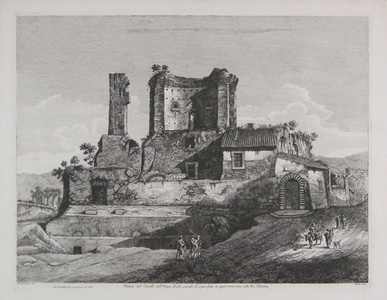| Method | Etching with engraving |
| Artist | Luigi Rossini |
| Published | Rossini dis. e inc. Roma 1822 |
| Dimensions | Image 445 x 337 mm, Plate 393 x 510 mm, Sheet 527 x 510 mm |
| Notes |
Plate 26 from Le Antichita Romane, ossia Raccolta della piu interessanti Vedute di Roma Antica, depicting the castellum, or reservoir, of the Julian aqueduct near the Via Tiburtina. The structure is shown in a ruinous state, with a team of excavators working at its base. The arches of the Julian aqueduct can be seen in the distance. The Aqua Julia was built in 33 AD by the Roman general Agrippa to supply water to the Caelian and Aventine hills. The aqueduct was repaired and expanded by Augustus during the last decade of the 1st century BC. Le Antichita Romane, ossia Raccolta della piu interessanti Vedute di Roma Antica was Rossini's largest series of engravings, and the most popular with his clients. The 101 plates of views of the remains of Ancient Rome were completed between 1819 and 1823. The influence of Piranesi and the other great etchers of the 18th century is immediately apparent when looking at Rossini's work. In some cases, Rossini's perspectives match almost exactly those executed by Piranesi in the previous century, with an equal attention to architectural detail. As a result, the viewer is provided with a fascinating record of the changes wrought on Rome's most famous monuments in the time between the two artists. Luigi Rossini (1790-1857) was an Italian painter and etcher. Born in Ravenna, he studied art and architecture at the Academy of Bologna with Antonio Giuseppe Basoli and Giovanni Antonio Antolini. He graduated in 1813. Similarly to Giovanni Battista Piranesi, Rossini is best known for etchings of classical Roman architecture including the Pantheon, the Colosseum, the Appian Way, the Temple of Peace, and the Golden House of Nero. Rossini was also influenced by more rural settings, and produced etchings of the landscape surrounding Rome. His first series of views were published in 1814. He began his Roman antiquities series in 1819, completing 101 large folio plates which were published in Rome in 1825. Condition: Trimmed to plate at left and right margins, staining to platemark not affecting image. |
| Framing | unmounted |
| Price | £300.00 |
| Stock ID | 4567 |

